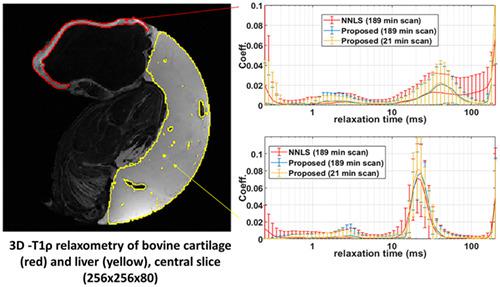当前位置:
X-MOL 学术
›
NMR Biomed.
›
论文详情
Our official English website, www.x-mol.net, welcomes your feedback! (Note: you will need to create a separate account there.)
Fast multicomponent 3D-T1ρ relaxometry.
NMR in Biomedicine ( IF 2.9 ) Pub Date : 2020-05-02 , DOI: 10.1002/nbm.4318 Marcelo V W Zibetti 1 , Elias S Helou 2 , Azadeh Sharafi 1 , Ravinder R Regatte 1
NMR in Biomedicine ( IF 2.9 ) Pub Date : 2020-05-02 , DOI: 10.1002/nbm.4318 Marcelo V W Zibetti 1 , Elias S Helou 2 , Azadeh Sharafi 1 , Ravinder R Regatte 1
Affiliation

|
NMR relaxometry can provide information about the relaxation of the magnetization in different tissues, increasing our understanding of molecular dynamics and biochemical composition in biological systems. In general, tissues have complex and heterogeneous structures composed of multiple pools. As a result, bulk magnetization returns to its original state with different relaxation times, in a multicomponent relaxation. Recovering the distribution of relaxation times in each voxel is a difficult inverse problem; it is usually unstable and requires long acquisition time, especially on clinical scanners. MRI can also be viewed as an inverse problem, especially when compressed sensing (CS) is used. The solution of these two inverse problems, CS and relaxometry, can be obtained very efficiently in a synergistically combined manner, leading to a more stable multicomponent relaxometry obtained with short scan times. In this paper, we will discuss the details of this technique from the viewpoint of inverse problems.
中文翻译:

快速多分量 3D-T1ρ 弛豫测量法。
NMR 弛豫测量可以提供有关不同组织中磁化强度弛豫的信息,增加我们对生物系统中分子动力学和生化成分的理解。通常,组织具有由多个池组成的复杂和异质结构。结果,体磁化在多分量弛豫中以不同的弛豫时间返回到其原始状态。恢复每个体素中弛豫时间的分布是一个困难的逆问题;它通常不稳定并且需要很长的采集时间,尤其是在临床扫描仪上。MRI 也可以被视为一个逆问题,尤其是在使用压缩感知 (CS) 时。这两个逆问题 CS 和弛豫测量的解决方案可以以协同组合的方式非常有效地获得,导致以较短的扫描时间获得更稳定的多分量弛豫。在本文中,我们将从逆问题的角度讨论该技术的细节。
更新日期:2020-05-02
中文翻译:

快速多分量 3D-T1ρ 弛豫测量法。
NMR 弛豫测量可以提供有关不同组织中磁化强度弛豫的信息,增加我们对生物系统中分子动力学和生化成分的理解。通常,组织具有由多个池组成的复杂和异质结构。结果,体磁化在多分量弛豫中以不同的弛豫时间返回到其原始状态。恢复每个体素中弛豫时间的分布是一个困难的逆问题;它通常不稳定并且需要很长的采集时间,尤其是在临床扫描仪上。MRI 也可以被视为一个逆问题,尤其是在使用压缩感知 (CS) 时。这两个逆问题 CS 和弛豫测量的解决方案可以以协同组合的方式非常有效地获得,导致以较短的扫描时间获得更稳定的多分量弛豫。在本文中,我们将从逆问题的角度讨论该技术的细节。

























 京公网安备 11010802027423号
京公网安备 11010802027423号